Early Days - Hailes and Wester Hailes
Until the mid 1700s, Fernieflat was not a separate farm, but part of the Hailes, later Wester Hailes, Estate. The first documented mention of the Hailes Estate was in the 11th Century when the superiority of the lands of Hailes was gifted by Ethelred, third son of Malcolm III (Malcolm Canmore) to the Church of the Holy Trinity at Dunfermline in about 1095.
The first recorded proprietor of Hailes was Archibald of Douglas. In a charter dated not later than 1198 the lands of Hailes passed from him to Thomas, son of Edward Logan of Restalrig. Hailes remained in the Logan of Restalrig family until 1438 when it was granted by charter to Sir William Crichton, first Lord Crichton, who was Master of the Royal Household of King James I and was also Sheriff of Edinburgh and Governor of Edinburgh Castle. The lands passed to his son, James, and then to James’s son, William, third Lord Crichton. He forfeited the lands in 1483 or 1484 as a result of, amongst other things, fortifying Crichton Castle against James III.
From the early 1500s the Hailes Estate was divided into Easter and Wester (sometimes Nether) Hailes.
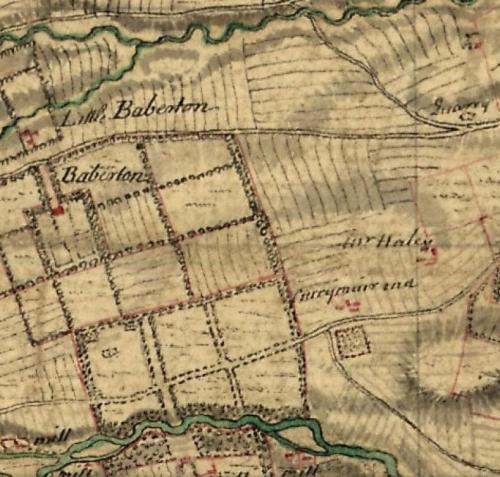 |
| William Roy's Military Survey c1750 |
Adam Otterburn, in his capacity as one of the Lords of Council, was a signatory to several surviving legal documents held in the National Records of Scotland. In documents dated 1516 and 1517 he is described as Adam Otterburn of Wester Hailes. He acquired the lands of Easter Hailes and Redhall at about the same time, and he was also the builder of Auldhame Castle three miles east of North Berwick. Following his death, Wester Hailes may have passed to Sir Adam’s son and grandson but no further information exists on the estate until some time between 1557 and 1585 when Wester Hailes was granted to William Murray of Touchadam, which was in St Ninians parish, Stirlingshire.
Wester Hailes remained in the Touchadam family for two more generations until 1625 when a charter was granted by the family to Sir James Murray of Kilbaberton, Master of Works to the King. Charles I ratified this charter in 1626. Sir James immediately settled Wester Hailes on his second son, also named James.
Wester Hailes was then acquired by Alexander Brand, probably in 1658. He was also the proprietor of the Baberton and Redhall Estates. In the 1670s he settled the land on his eldest son, James, but Alexander reserved the right to live in the property during his lifetime. James died in 1682, before his father, and on Alexander’s death in 1691 it passed to James’s son, also named Alexander Brand. This Alexander Brand was married to Helen Craig, the daughter of Lewis Craig of Riccarton. There was then a complicated series of marriages that connected the Craig, Gibson and Carmichael families for several generations.
In 1699, Wester Hailes was acquired by Robert Craig of Riccarton from Alexander Brand, his brother-in-law, for the sum of £21,094 Scots money. £12 Scots pounds equalled one pound Sterling so £21,094 was about £1758 Sterling. Using average earnings as a comparison, this equates to about £3.5 million in today’s money.
John Mushet was then briefly proprietor and in 1710 Wester Hailes was acquired by The Honorable William Carmichael of Skirling. William Carmichael was married to another Helen Craig, the daughter of Thomas Craig of Riccarton. The Carmichaels, later Gibson-Carmichaels possessed Wester Hailes for nearly 200 years. William Carmichael passed Wester Hailes to his second son,James Carmichael W.S. in 1749. It is around this time that the estate first appears on maps and plans. William Roy’s Military Survey of about 1750 shows Wester Hailes Farm and Curriemuirend, but there is no sign of Fernieflat Farm.
Enclosure of the Land
The mid-1700s was a time of great change in farming practices in Scotland and farms began to be split into separate fields which were enclosed typically by hedges. As part of this, many estates were surveyed and estate plans exist for the first time. There is such a plan for Wester Hailes. It was done by David Mather, surveyor, in 1755 for James Carmichael. The plan is not in good shape but the interesting point is that it does show a farm where Fernieflat was, but it is referred to as Newhaills.
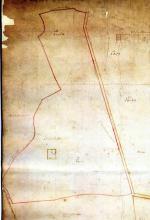 |
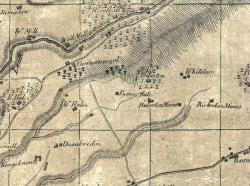 |
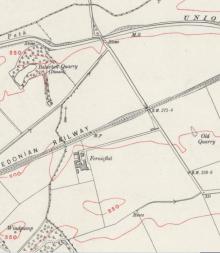 |
| Newhaills in 1755 | John Laurie's map of 1763 | Fernieflat in 1923 |
A section of the plan is shown alongside a later plan for comparison.
The 1755 plan is not very clear but the outline can becompared to the later plan which clearly shows Fernieflat Farm buildings in the same location as the buildings in 1755. Other than the canal and railway lines cutting across the farm, it changed very little in 200 years. The name of Newhaills was short lived because by the time of John Laurie’s map of 1763, the farm is called “Fairnie Flate”. This is a slightly odd map as it is inverted, with east on the left and west on the right.
These maps show that Fernieflat as a name came into being some time between 1755 and 1763, although the farm itself was already there in 1755. James Carmichael also acquired Easter Hailes, from George Drummond, Lord Provost of Edinburgh, in 1751.
At some point before 1762, James Carmichael’s Hailes Estate was enclosed. The following transcript comes from the decisions of the Court of Session that year:-
A proof having been taken, the Sheriff found it proven, ‘That the defender Richard Vary has hunted with a pack of hounds on the grounds belonging to the complainers James Watson and James Carmichael of Hailes, after the wheat thereon was brierded, and that he once brushed through the hedge of an inclosure belonging to the said Mr Carmichael; found, that the said defender had no right to hunt with the said pack of hounds on the grounds belonging to any of the complainers and therefore prohibited and discharged him from hunting thereon in time coming...
(“brierded”means newly grown.)
James Carmichael commissioned Sir James Clerk of Penicuik to design Hailes House for him in around 1760. The house still stands, now in Hailes Avenue, although it has been substantially altered. James Carmichael died unmarried in 1781 and Fernieflat and Wester Hailes passed to his older brother John, the 4th Earl of Hyndford. He died soon afterwards, in 1787, and was succeeded by his grand-nephew, John Gibson. As part of the rules of this succession John Gibson had to take the name of Carmichael and the family became known as Gibson-Carmichael. Several further generations of the Gibson-Carmichael family owned Fernieflat Farm until in 1898, along with other land in the area, the farm was sold to the Hailes Estate and Quarry Company.
Tenants and Later Years
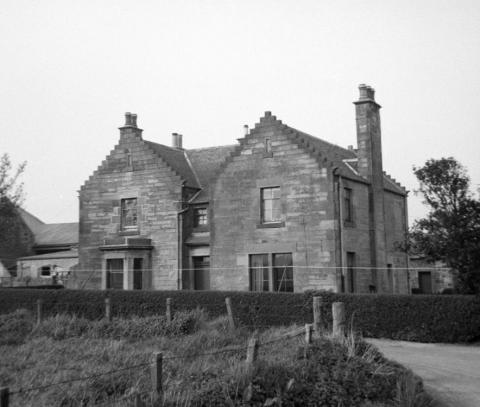 |
| Fernieflat farmhouse (Copyright RCHAMS) |
Fernieflat was farmed by a tenant farmer who lived in the farmhouse. Typically a “tack”or tenant contract was for nineteen years. The first documented tenant of Wester Hailes in 1686 was George Davie whose family were tenants for several further generations. In 1800 the tenant of Fernieflat Farm was Robert Semple. From 1841 to the mid 1870s it was William Lawrie. Although he won prizes in the 1850s for his horses, by 1874 William was in so much debt that he was declared bankrupt and had to sell all his crops and stock. He even had to sell the contents of the farmhouse. The court papers itemise everything in detail. His stock included 6 horses, 1 foal, 2 cows, 2 heifers, 1 calf and 4 pigs. The crops included barley, hay, potatoes and turnips.
The next tenant was Gilbert Meikle, from Carnwath, who started a long association between the Meikle family and Fernieflat Farm. Not long after he took over the tenancy, there was a disastrous fire, described in the Evening News of 16th September 1878. Gilbert had a large family and by the time of his death in 1896 his eldest son James was farming at Fernieflat and his second son Gilbert was the tenant of the neighbouring Baberton Mains Farm. The first disaster for James Meikle at Fernieflat was the suicide of Robert Young, the long-serving manager of Hailes Quarry. As reported by The Scotsman of February 1 1901 it happened in Fernieflat’s “straw shed while the farmer was yoking his horse to convey Mr Young home”. The quarry closed in 1902 so perhaps looming redundancy contributed to the tragedy.
History repeated itself in 1908 when there was another, less serious fire at Fernieflat. In October 1908, James Meikle was woken in the night by a huge stackyard blaze which was visible from the Central Fire Office in Edinburgh. His workmen got the 45 cows and nine horses to safety but £1500 worth of corn, hay and straw went up in flames.
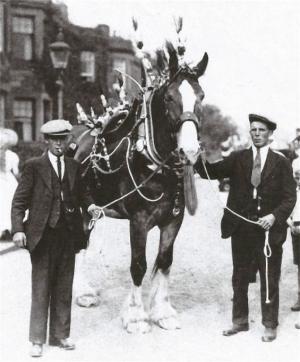 |
| Nippy and handlers |
James Meikle died in 1916 and had no children, so the tenancy was taken over by his nephew and niece, William and Helen Meikle. They continued the tenancy until William’s death, eventually purchasing the farm by public roup in 1920 from the Hailes Estate and Quarry Company for £11,150 (about £1.16 million in today’s money). They set about improving their four cottages and lavished care and attention on their heavy horses. They showed them at the Juniper Green Gala and in 1937 got to keep the cup for “best dressed horse”after winning it three times in a row against what The Scotsman called “keen competition”. One of the horses was “Nippy”shown here with his handlers in Juniper Green in about 1935.
William and Helen Meikle farmed the land until William’s death in 1948. Helen tried to continue but offered the 160 acres at an upset price of £17,500 to Robert Russell, farmer and cattle dealer from West Calder, in 1951. Robert Russell was a sociable man. He bought cattle in Lanark and sold them on through Gorgie market (sometimes carrying calves in the back of his saloon car!)
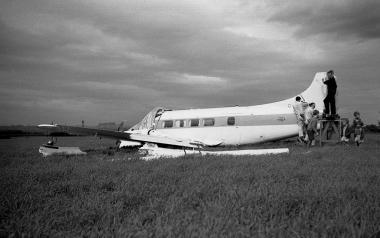 |
| G-ANDY plane crash at Fernieflat Farm |
It was during Robert Russell’s time as owner that there was great excitement when a plane crashed into the fields of Fernieflat Farm. On the 29th May 1962 a de Havilland DH.104 Dove 6, registration G-ANDY, owned by Ferranti, took off from Turnhouse airport with two people on board. According to the pilot’s son, Ferranti had owned the plane for just about a week. His father, who was the chief pilot for Ferranti, crashed the plane on a test flight. It is thought that the pilot shut an engine down on take-off to give the co-pilot experience of a dead engine. He couldn't restart it and the plane would not climb. Newspapers reported that the plane struck high tension cables and collided with telephone wires and a pole. It came to rest in the barley field which Fernieflat Farm cottages bordered. Thankfully the two men on board were not badly injured. The exact location of the crash is difficult to pinpoint but it was somewhere around what is now the south east corner of the green area in the middle of Baberton Mains Estate.
Robert Russell sold a parcel of Fernieflat land to the city in 1967 and then borrowed £87,500 from Wimpey in 1969 against the 68 acres of the future estate. This land was handed over in 1971 and he took up a big farm in the Borders. In the ’70s and 80s more pieces of the land were sold to accommodate the bypass but George Wimpey’s workforce got cracking and in June 1972 No. 67 Baberton Mains Drive was the first house on the new estate to be legally registered. The lucky owner was Alexander. P. McD. Motion!